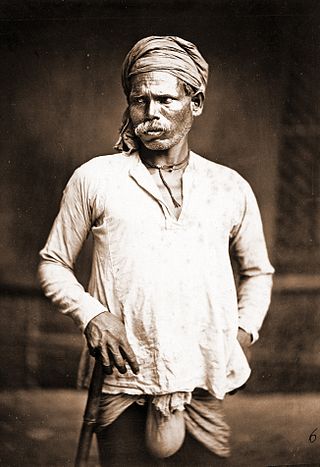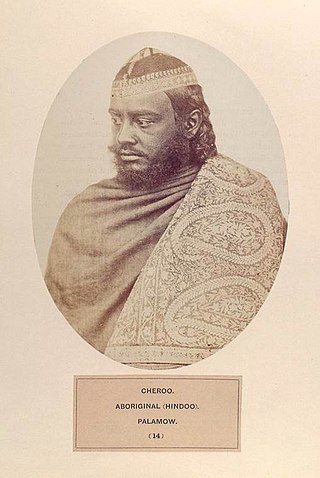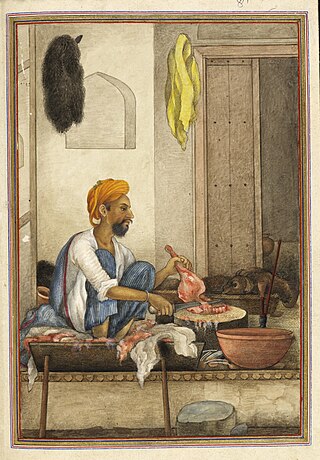The Valmikis are a variety of communities throughout India who all claim descent from the legendary author of the Ramayana, Valmiki. The Valmikis can be classified as a caste or sampradaya (tradition/sect).

The Dom, also known as Domra, Domba, Domaka, Dombara and Dombari, are castes, or groups, scattered across India. Dom were a caste of drummer. According to Tantra scriptures, the Dom were engaged in the occupations of singing and playing music. Historically, they were considered an untouchable caste called the Dalits and their traditional occupation was the disposal and cremation of dead bodies. They are in the list of Scheduled caste for Reservation in India in the Indian states of Uttar Pradesh, Bihar, Odisha, Andhra Pradesh, Jharkhand and West Bengal.

The Baiga are an ethnic group found in central India primarily in the state of Madhya Pradesh, and in smaller numbers in the surrounding states of Uttar Pradesh, Chhattisgarh and Jharkhand. The largest number of Baiga is found in Baiga-chuk in Mandla district and Balaghat district of Madhya Pradesh. They have sub-castes: Bijhwar, Narotia, Bharotiya, Nahar, Rai maina and Kath maina. The name Baiga means "sorcerer-medicine man".

Chandauli district is a district of Uttar Pradesh state of India, and Chandauli town is the district headquarters. Chandauli district, a part of Varanasi Division, became a separate district on 20 May 1997.
The Majhwar are a Scheduled Caste found in the state of Uttar Pradesh in India.

Kunda is a town and a Tehsil in Pratapgarh district in the Indian state of Uttar Pradesh.
The demographics of Uttar Pradesh is a complex topic, which is undergoing dynamic change. Uttar Pradesh is India's most populous state, and the largest subdivision in the world. It has a population of about 199,812,341 as per the 2011 census. If it were a separate country, Uttar Pradesh would be the world's fifth most populous nation, next only to China, the rest of India, the United States of America and Indonesia. Uttar Pradesh has a population more than that of Pakistan. There is an average population density of 828 persons per km2 i.e. 2,146 per sq mi. The capital of Uttar Pradesh is Lucknow, and Prayagraj serves as the state’s judicial capital. Hindus and Muslims both consider the state as a holy place.
The Ahirwar, or Aharwar are Dalit members of a north Indian caste categorised among the Scheduled Castes of Chamar. Predominantly are members of the Scheduled Castes with a higher population in Uttar Pradesh, Madhya Pradesh.
The Sahariya are a community found in the Bundelkhand region of North India, which is administered by the states of Madhya Pradesh and Uttar Pradesh. They are also known as Rawat, Banrawat, Banrakha and Soarain.
The Lal Begi, or Lalbegi, or Lala Baig are a Chuhra caste found in the states of Bihar and Uttar Pradesh in India, as well as in Multan, Dera Ghazi Khan and Bahawalpur in Pakistan.

The Chero is a caste found in the states of Bihar, Jharkhand and Uttar Pradesh in India.
The Bansphor are a Hindu caste found in the state of Uttar Pradesh, India.
The Domar are a Hindu caste found in the state of Karnataka in India.

The Badhik, or sometimes pronounced Badhak a Hindu caste engages in the profession of butcher are found in the states of Uttar Pradesh, Rajasthan and Haryana in India. They have been granted scheduled caste status in Uttar Pradesh.
The Bhuiyan or Bhuiya are an indigenous community found in the Indian states of Bihar, Jharkhand, Madhya Pradesh, Odisha, Uttar Pradesh and West Bengal. They are not only geographically disparate but also have many cultural variations and subgroups.
The Kalabaz are a Hindu caste found in the state of Uttar Pradesh in India. They have Scheduled Caste status.
The Patari are a community found mainly in the Sonbhadra district of Uttar Pradesh, India.
The Kharot are a Scheduled Caste found in the state of Uttar Pradesh in India. They are an endogamous sub-group within the Beldar caste, and are found mainly in eastern Uttar Pradesh. The name kharot is said to be derived from the Sanskrit word khata, which means grass. They were historically associated with the manufacture of mats from grass, and the word kharot literally means a grass mat manufacturer.
Kori is an Indian caste, who were traditionally weavers. They are descendants of Ishvakuwanshi Raja Mandhata ji and Saint Kabir Das Ji Maharaj. KORI and KOLI are same Castes!!But Due to Sanskrit Translate of Pali Words, The L (ला) is Written and Spoken as R (र)!!

Bisauri is a village of the Jaunpur district, Uttar Pradesh, Northern India. Bisauri's Postal Index Number is 222129 and its post office is at Patrahi. The village is also a Gram Panchayat, comprising itself and the village of Tiwaripur.






